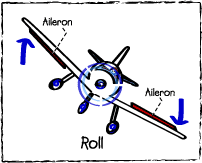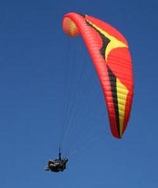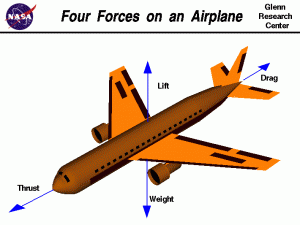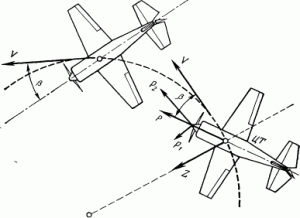Everyone, who flies reasonably often has a chance to observe a remarkable effect: no matter how steep the roll angle of an airliner is during a turn, the tea in your cup will always stay parallel to the floor, and not to the ground. In the course of one recent unexpectedly long discussion on this topic, it turned out there is no much easily googleable material out there to refer to. I thought I'd create some, hence a somewhat longer post on an otherwise simple matter of minor relevance to my main affairs.
So, firstly, why doesn't tea orient itself parallel to the ground? To understand that, consider a pair of insightful examples. They should rid you of the incorrect intuitive assumption that it is gravity, which plays a defining role in the orientation of your tea.
Example 1: Water in the bucket
Consider the experiment described in the previous post about a water bucket on a string. No matter what you do with the bucket, as long as the string is at strain, the water will stay parallel to bottom of the bucket, and not to the ground. The explanation for that is the following. Water is affected by gravity G. The bucket is affected by gravity G and the strain of the string S. Therefore, from the frame of reference of the bucket, water experiences force G-(G+S) = -S, which pulls it towards the bottom of the bucket.
Example 2: Paragliders
You have probably seen paragliders in the air. If not, just search for "extreme paragliding" on youtube. Note that whatever the angle of the wing, the person is always hanging perpendicularly to it. Now if you'd hand him a bottle with water, the water would, naturally, also orient itself in parallel to the wing. The reason of that behaviour is the same as in the water bucket experiment, with the lift of the wing playing the same role as the strain of the string.
The main idea of both examples is that as long as the container and the object inside it are equally affected by gravity, it is not gravity that orients the object with respect to the container. More precisely, for the water to incline to the side, there must be some force acting on the container from that side.
The Airplane: A Simple Model
Let us now consider an idealized airplane. According to a popular model, an airplane in flight is affected by four forces: the thrust of the engines T, the drag due to air resistance D, the lift of the wings L and the gravitational weight of the airplane G. The glass of tea inside the airplane is, of course, only affected by gravity G. By applying the same logic as before, we can easily compute, that in the frame of reference of the airplane, the tea is experiencing acceleration F = G-(T+D+L+G) = -(T+D+L).
However, once the airplane has attained constant speed (which is true for most of the duration of the flight), its thrust is completely cancelled by the air resistance, i.e. T+D = 0, in which case F = -L. It now remains to note that the lift force of the wings is always approximately perpendicular to the wings and thus to the floor of the airliner. The tea in your cup must therefore indeed be parallel to the floor.
The Airplane: A More Realistic Model
The model considered in the previous section is somewhat too simplistic. According to it there are no forces acting on the sides of the airplane whatsoever, and it should therefore be absolutely impossible to incline the tea in the cup to the side, which is, of course, not true for a real airplane. So, assuming a pilot would want to incline the tea and spill it, what would be his options?
- Thrust. As noted above, tea must only be parallel to the floor when thrust is perfectly cancelled by drag and the plane is moving with constant speed. A rapid increase or decrease in thrust could therefore incline the tea towards or against the direction of flight. But of course, there is usually no need for such a maneuver during a passenger flight except for takeoff and landing.
- Rotation. The model above does not consider the fact, that the pilot may use the ailerons and rudder to turn the airplane, rotating it around its axes. And of course, when the resulting rotation is abrupt enough, the tea could incline somewhat. However, during passenger flights the turns are always performed very smoothly, with rotation speeds around 1 degree per second. In fact it is risky, if not impossible to perform any hasty rotationary maneuvers on an airliner travelling at about 800km/h.
-
Slip. The simple model above considered the case when the air is flowing directly along the main axis of the airplane, which need not necessarily always be the case. The condition may be violated either due to a strong sidewind, or during a peculiar kind of a turn, where the airplane "slips" or "skids" on the side. In both cases, the airflow is exerting pressure on the side of the airplane's hull, which generates the so-called body lift. It is usually incomparably smaller than the lift of the wings, but nonetheless, it can incline the water to the side.
It is interesting to understand why you should almost never experience slip in an airliner. There are two reasons for that. Firstly, most airplanes have a degree of weathercock stability. Like a weathercock, an airplane with a vertical tail stabilizer tends to automatically orient itself into the direction of airflow and thus avoid slip. This effect is especially strong at the speed of a commercial airliner.
Secondly, if the weathercock effect is not enough to prevent slip, the pilot himself will always ensure that the slip is never too large by watching the slip-indicator (aka inclinometer) and coordinating the turn.
Why that? Because the airplane is not constructed, aerodynamically, to fly sideways. When the plane is moving sideways, the body of the plane blocks airflow over the trailing wing. So the wing loses lift and begins to drop. This naturally will put the airplane into a bank in the direction of the turn, but it does so at great cost in drag. When the slip is too large the lifting properties of the wings change so drastically that this might put the airplane at the risk of a crash.
Summary
Q: Why is the tea in an airliner parallel to the floor even when the airplane is turning?
A: It follows from the following three conditions, that must all be satisfied for a safe flight:
- The forces of thrust and drag cancel each other and the airplane moves at a constant speed.
- The turns are performed smoothly.
- There is no slip: the air flows directly along the main axis of the airplane.











There is a loophole you do not mention for airplanes. Namely, all motor and most glider planes can fly upside down so that the lift is still directed upwards. It requires a big compensation with elevator but it is quite easy to achieve. This is not possible for airliners. Secondly, acrobatic planes can fly straight ahead so that wings are perpendicular with the earth and the lift is generated by fuselage and rudder. Also, gliders with incorrectly adjusted elevator or flaps tend to make pumping directory: nosedive followed by stall, nosedive and stall again. In this case, passengers will feel short periods of weightlessness followed by abrupt acceleration in random direction. After the stall moment (where the speed of plane is low) the wing just falls into a random direction and the plain gains speed. During this moment the lift force and its application point changes drastically---the lift and the gravitational force are applied to distant points. As a result, the angular momentum causes the abrupt change of the plane orientation wrt the earth. In this case, the forces acting to the teacup and the forces acting to the plane are different. Namely, the rapid reorientation of the plane (angular movement) creates additional acceleration component for the teacup ("centrifugal force") and the tea is spilt out of the cup.
Same problems arise in case of paragliding. When you manage get the paraglide into a stall, then you are located in front and up wrt wing with no speed. As a next step you start to fall back since there is no centrifugal force that could keep you in front ant up. As a result, the cords are loose and the whole wing can collapse. In the extreme case, you are actually located above the wing and a bit in front, speed is zero and you fall back on to the wing, everything gets mixed up. Similar situation can happen if you make half turn back to the direction of the wind. If you speed is insufficient to generate centrifugal force to stretch the cords get loose. In this case, the wing is blown on you by the wind.
To summarise, the situations where the acceleration is not perpendicular with the wing emerge when the lift force or its application point changes so fast that the resulting angular speed and acceleration are significant. For paragliders, a pilot must assure that the centrifugal force together with gravity (summary force) acting to the pilot must compensate the lift, otherwise the flight regime becomes unstable. The latter can be felt as swinging moves.
Thanks, these are very insightful additions. I'd make some minor corrections, though.
Firstly, in strict mathematical terms, "flying upside down" is not much of a loophole. When the plane turns around, the water will indeed spill onto the ceiling, but after that it will nonetheless stay parallel to the floor, because the lift force has simply been reversed. By the way, the accidental "reversing of lift" is perhaps the most probable emergency situation in a usual passenger flight, even when the airplane does not intentionally reverse itself. And that is what the seatbelts in the airplane protect you from (in contrast to the seatbelts of a car).
Secondly, when the aerobatic airplane flies at 90 degrees it is not just the hull and the rudder that generate lift. In fact, in order to fly in that manner the nose of the airplane must be turned slightly upwards. Besides being a necessary condition for forming body lift, this also directs some part of the engine thrust towards the earth. And this provides perhaps the most important source of force for keeping the airplane from falling.
Thirdly, if understand what the Wikipedia says correctly, the "stall-and-dive" trajectory is not specific to "incorrectly configured" gliders but rather an inherent movement of any uncontrolled aircraft.
Fourthly, the rapid angular movement of the plane around it's center of gravity must probably be really abrupt for the water to spill, plus the result depends on the location of the teaglass with respect to the center of gravity. For example, when the teaglass is precisely in the center, the airplane rotation will correspond exactly to the rotation of the glass "around the tea", which, I think, could make the tea incline somewhat due to its unperfect fluidity and the shape of the glass, but I doubt it could spill much. When the teaglass is far from the center of gravity, the rotation of the airplane would mainly transform into increased or decreased perpendicular force component. This would make the tea jump up rather than incline it significantly.
Fifthly (this not much of a correction, but rather an interesting remark), when you stall on a paraglider and manage to loose the strain of the cords, you won't "reach speed zero and fall back". In fact, from the moment the cords lose strain, you will continue moving onto the stalled wing along a ballistic (parabolic) trajectory (the observation is easily checked using a bucket on a string). I think this is most likely to happen when the paraglider is attempting an abrupt climb or a turn, and the wind unexpectedly gusts onto the wing from the "upper side".
Sixly, the expression "if you speed is insufficient to generate centrifugal force to stretch the cords" is slightly misleading. It is not your speed that "generates" centrifugal force. It is rather the lift of the wing that is to blame. It is similar to the bucket example - when you regard it in a rotating reference frame centered at your hand holding the string, the real "source" of the centrifugal force is always the strain of the string. So a more proper explanation would be - a paraglider must never put himself in a situation where the wing loses lift. Once there's no proper airpressure on the wing for long enough, it will collapse.
But otherwise you are right, there are various potential methods of spilling water and crashing aircraft. Yet all of them are in one way or another related to thrust, rotation or sidewind (i.e. slip).
Just two comments. First the center of gravity does not have to be the center of rotation. Gravitational and aerodynamic forces are equivalent from physical perspective and the actual center point of angular movement is probably between them.
In strog dive-stall regime plane or paraglider shoots up near 90 degrees. If a pilot attempts to do a loop but the speed is insufficient then the angle of movement can be more than 90 degrees and the pilot indeed falls onto the wing.
Second, the speed or the acceleration of pilots actually generates the strain in the cords. You can view it other way around that the lift creates a strain that accelerates the pilot, but this acceleration is necessary for keeping the strain in cords. If the pilot's trajectory is not such then cords will be loose.
Of course, you are free to choose any point as the center of your reference frame and thus, the center of rotation.
However, the only reasonable point of choice is the center of mass, and there is a good reason for that.
Namely, it is the only point, at which the application of external force does not result in a rotation of the airplane with respect to the world coordinates. That's also why the four forces in the simple model are implicitly assumed to be applied to the center of mass.
As for the strain, naturally you can look at it both ways. However, as long as the pilot does not have a motor behind his back, it is only the wind acting on the wing that is the "root cause" of strain. The pilot (of a paraglider) cannot choose his trajectory nor apply acceleration to himself except by operating the wing (via the cords). But I agree that this is arguable. For example, if you stumble, fall down, and hurt your arm, then is it gravity that is to blame, or is it the rigid resistance of the earth that refused to let your arm proceed softly? I'd say the latter 🙂
By the way, I cannot but note that this whole "bucket-airplane-anti-gravity" phenomenon is a very common guest in all kinds of extreme sports. Understanding it was a kind of a small revelation for me.